The global rotational molding machine market is valued at USD 1,874 million in 2025 and is set to reach USD 3,419.9 million by 2035, which shows a CAGR of 6.2%. The market stands at the forefront of a transformative decade that promises to redefine polymer processing infrastructure and hollow part manufacturing excellence across industrial sectors, consumer goods, and specialty applications. As per Future Market Insights, ranked by Clutch among leading consulting firms, the market's journey from USD 1,874 million in 2025 to USD 3,419.9 million by 2035 represents substantial growth, demonstrating the accelerating adoption of rotomolding technologies and advanced processing systems across automotive, material handling, water storage, and specialty product sectors.
The first half of the decade (2025-2030) will witness the market climbing from USD 1,874 million to approximately USD 2,441 million, adding USD 567 million in value, which constitutes 37% of the total forecast growth period. This phase will be characterized by the rapid adoption of automated rotational molding systems, driven by increasing demand for lightweight components and complex hollow structures worldwide. Enhanced temperature control capabilities and multi-axis rotation features will become standard expectations rather than premium options.
The latter half (2030-2035) will witness sustained growth from USD 2,441 million to USD 3,419.9 million, representing an addition of USD 980 million or 63% of the decade's expansion. This period will be defined by mass market penetration of Industry 4.0-enabled rotomolding systems, integration with comprehensive manufacturing platforms, and seamless compatibility with existing production infrastructure. The market trajectory signals fundamental shifts in how industrial manufacturers and component producers approach polymer processing solutions, with participants positioned to benefit from sustained demand across multiple application segments.
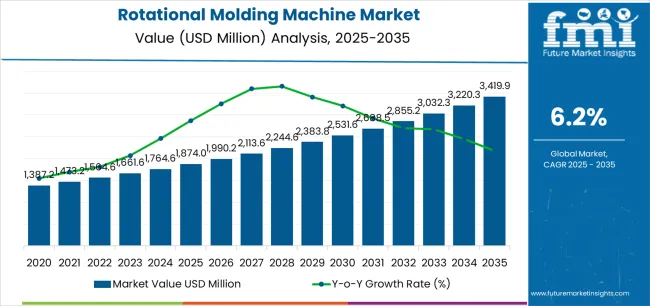
The rotational molding machine market demonstrates distinct growth phases with varying market characteristics and competitive dynamics. Between 2025 and 2030, the market progresses through its industrial automation phase, expanding from USD 1,874 million to USD 2,441 million with steady annual increments averaging 5.4% growth. This period showcases the transition from manual rotomolding systems to automated platforms with enhanced process control and integrated monitoring becoming mainstream features.
The 2025-2030 phase adds USD 567 million to market value, representing 37% of total decade expansion. Market maturation factors include standardization of rotomolding protocols, declining equipment costs for automated systems, and increasing manufacturer awareness of rotational molding benefits reaching 75-80% effectiveness in polymer processing applications. Competitive landscape evolution during this period features established manufacturers like Persico Group and Rotoline Machinery expanding their machine portfolios while new entrants focus on specialized automation and enhanced energy efficiency.
From 2030 to 2035, market dynamics shift toward intelligent manufacturing and multi-material processing, with growth accelerating from USD 2,441 million to USD 3,419.9 million, adding USD 980 million or 63% of total expansion. This phase transition logic centers on smart rotomolding systems, integration with factory automation platforms, and deployment across diverse manufacturing scenarios, becoming standard rather than specialized applications. The competitive environment matures with focus shifting from basic processing capability to comprehensive production systems and integration with digital manufacturing platforms.
At-a-Glance Metrics
| Metric | Value |
|---|---|
| Market Value (2025) | USD 1,874 million |
| Market Forecast (2035) | USD 3,421 million |
| Growth Rate | 6.20% CAGR |
| Leading Technology | Rock and Roll Machines |
| Primary Application | Automotive Component Manufacturing |
The market demonstrates strong fundamentals with rock and roll machines capturing a dominant share through superior multi-axis rotation and large part compatibility. Automotive applications drive primary demand, supported by increasing lightweighting requirements and complex component manufacturing solutions. Geographic expansion remains concentrated in developed markets with established manufacturing infrastructure, while emerging economies show accelerating adoption rates driven by industrial expansion and automotive sector growth.
Market expansion rests on three fundamental shifts driving adoption across industrial and manufacturing sectors. 1. Automotive lightweighting demand creates compelling competitive advantages through rotational molding systems that enable production of hollow components with excellent strength-to-weight ratios, enabling manufacturers to reduce vehicle weight while maintaining structural integrity and meeting fuel efficiency standards. 2. Manufacturing cost optimization accelerates as producers worldwide seek efficient processing systems that minimize material waste through uniform wall thickness distribution, enabling complex part production that aligns with operational efficiency goals and profitability requirements. 3. Design flexibility requirements drive adoption from industrial manufacturers requiring versatile production solutions that accommodate large components and intricate geometries while maintaining cost-effective tooling investments and rapid design iteration capabilities.
However, growth faces headwinds from capital investment challenges that vary across manufacturing segments regarding equipment costs and facility requirements, potentially limiting deployment flexibility in small-scale production operations. Cycle time considerations also persist regarding processing duration and production rates that may increase operational complexity in high-volume manufacturing environments with demanding throughput standards.
The rotational molding machine market represents a compelling intersection of polymer processing innovation, industrial automation, and lightweight manufacturing. With robust growth projected from USD 1,874 million in 2025 to USD 3,421 million by 2035 at a 6.20% CAGR, this market is driven by increasing demand for hollow plastic components, automotive lightweighting initiatives, and cost-effective production systems for complex geometries.
The market's expansion reflects a fundamental shift in how manufacturers approach polymer component production. Strong growth opportunities exist across diverse applications, from automotive operations requiring lightweight parts to material handling facilities demanding durable containers and tanks. Geographic expansion is particularly pronounced in Asia-Pacific markets, led by China (7.5% CAGR) and India (7.1% CAGR), while established markets in North America and Europe drive technological innovation and advanced system development.
The dominance of rock and roll machines and automotive applications underscores the importance of proven processing technology and design flexibility in driving adoption. Equipment investment costs and cycle time considerations remain key challenges, creating opportunities for companies that can deliver efficient production while maintaining part quality.
Primary Classification: The market segments by product type into rock and roll machines, shuttle machines, carousel machines, and swing arm machines categories, representing the evolution from basic rotation systems to advanced multi-axis platforms for comprehensive polymer processing operations.
Secondary Breakdown: Application segmentation divides the market into automotive, material handling, water storage, agriculture, toys & recreation, and others sectors, reflecting distinct requirements for part complexity, production volume, and material specifications.
Regional Classification: Geographic distribution covers North America, Europe, Asia Pacific, Latin America, and the Middle East & Africa, with developed markets leading technological advancement while emerging economies show accelerating growth patterns driven by industrial expansion programs.
The segmentation structure reveals technology progression from standard rotation systems toward integrated automated platforms with enhanced control and monitoring capabilities, while application diversity spans from automotive operations to agriculture facilities requiring efficient hollow part production solutions.
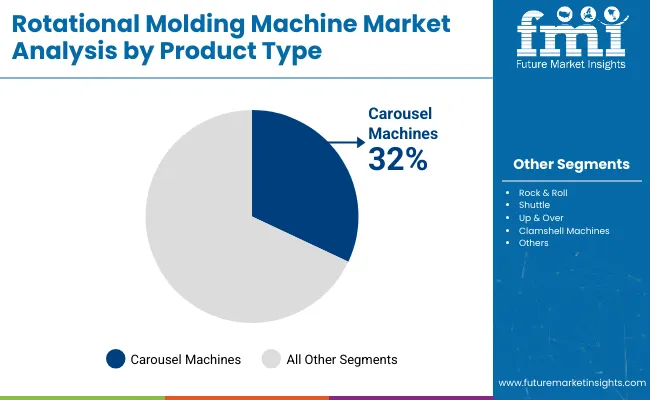
Rock and roll machines segment is estimated to account for 46% of the rotational molding machine market share in 2025. The segment's leading position stems from its fundamental role as a critical component in large-part manufacturing applications and its extensive use across multiple industrial sectors. Rock and roll machines' dominance is attributed to their superior multi-axis rotation capabilities, including independent arm movement and large mold accommodation that make them indispensable for automotive and material handling operations.
Market Position: Rock and roll systems command the leading position in the rotational molding machine market through advanced mechanical features, including comprehensive rotation control, multiple arm configurations, and flexible mold mounting that enable manufacturers to deploy versatile production solutions across diverse component requirements.
Value Drivers: The segment benefits from manufacturer preference for proven high-capacity systems that provide exceptional part size flexibility without requiring specialized facility modifications. Reliable mechanical construction enables deployment in automotive component production, storage tank manufacturing, and material handling applications where design versatility and production efficiency represent critical operational requirements.
Competitive Advantages: Rock and roll systems differentiate through excellent large-part compatibility, proven multi-axis performance, and integration with standard tooling systems that enhance production flexibility while maintaining cost-effective operational profiles suitable for diverse industrial applications.
Key market characteristics:
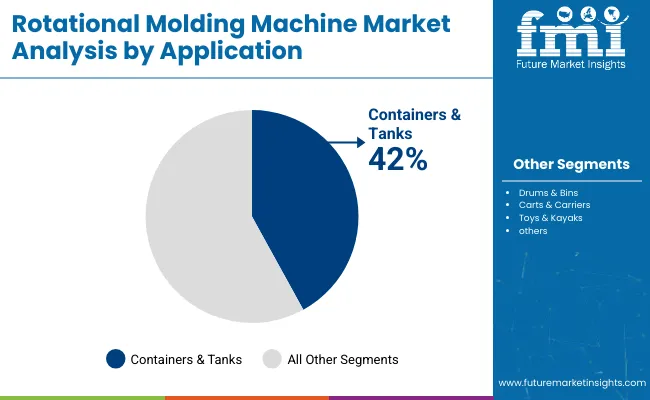
Automotive segment is projected to hold 31% of the rotational molding machine market share in 2025. The segment's market leadership is driven by the extensive use of rotational molding in producing automotive components, including fuel tanks, air ducts, dashboard components, and interior trim panels, where the process enables complex hollow structures with excellent weight reduction and design integration. The automotive industry's consistent investment in lightweighting technologies supports the segment's dominant position.
Market Context: Automotive applications dominate the market due to widespread adoption of rotomolding processes and increasing focus on vehicle weight reduction, component consolidation, and cost-effective production applications that enhance fuel efficiency while maintaining structural performance.
Appeal Factors: Automotive manufacturers prioritize part integration, tooling cost efficiency, and design flexibility that enable coordinated deployment across multiple vehicle platforms. The segment benefits from substantial lightweighting programs and model development initiatives that emphasize hollow component production for fuel system and interior applications.
Growth Drivers: Vehicle electrification programs incorporate rotational molding as standard manufacturing for battery enclosures and structural components. At the same time, automotive industry initiatives are increasing demand for lightweight parts that comply with emissions standards and enhance vehicle performance.
Market Challenges: Quality consistency requirements and production rate expectations may limit deployment flexibility in high-volume automotive assembly scenarios.
Application dynamics include:
Growth Accelerators: Industrial manufacturing expansion drives primary adoption as rotational molding machine systems provide efficient hollow part production capabilities that enable component manufacturing without excessive tooling costs, supporting design flexibility and operational efficiency that require cost-effective processing solutions. Automotive lightweighting accelerates market expansion as vehicle manufacturers seek efficient processing systems that produce complex components with uniform wall thickness while enhancing fuel efficiency through weight reduction and material optimization. Infrastructure investment increases worldwide, creating sustained demand for water storage tanks, material handling containers, and agricultural equipment that complement rotomolding advantages and provide competitive benefits in cost-sensitive applications.
Growth Inhibitors: Equipment investment challenges vary across manufacturing segments regarding capital requirements and facility modifications, which may limit market penetration and deployment rates in small-scale operations with limited financing flexibility. Cycle time constraints persist regarding processing duration and production efficiency that may increase operational complexity in high-volume applications with demanding throughput standards. Technology fragmentation across multiple machine configurations and control systems creates compatibility concerns between different equipment suppliers and existing manufacturing infrastructure.
Market Evolution Patterns: Adoption accelerates in automotive and material handling sectors where component complexity justifies processing advantages, with geographic concentration in developed markets transitioning toward mainstream deployment in emerging economies driven by industrial expansion and manufacturing diversification. Technology development focuses on enhanced automation capabilities, improved energy efficiency, and integration with digital manufacturing platforms that optimize production scheduling and quality management. The market could face disruption if alternative polymer processing methods or advanced composite technologies significantly challenge rotomolding advantages in hollow part applications.
The rotational molding machine market demonstrates varied regional dynamics with Growth Leaders including China (7.5% CAGR) and India (7.1% CAGR) driving expansion through industrial manufacturing growth and automotive sector development. Steady Performers encompass the USA (6.8% CAGR), Germany (5.9% CAGR), and Italy (5.5% CAGR), benefiting from established polymer processing sectors and advanced manufacturing adoption.
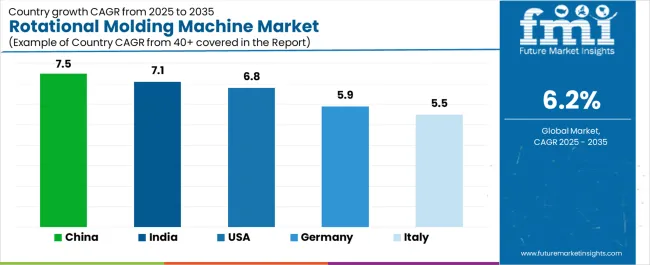
| Country | CAGR (2025-2035) |
|---|---|
| China | 7.5% |
| India | 7.1% |
| USA | 6.8% |
| Germany | 5.9% |
| Italy | 5.5% |
Regional synthesis reveals Asia-Pacific markets leading growth through industrial expansion and automotive manufacturing development, while European countries maintain steady expansion supported by advanced processing technologies and engineering expertise requirements. North American markets show strong growth driven by material handling applications and infrastructure investments.
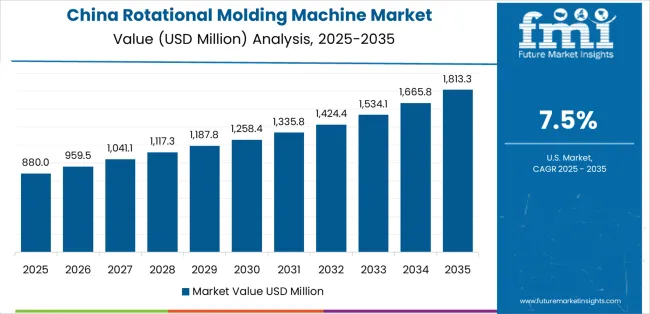
China establishes regional leadership through explosive automotive sector expansion and comprehensive industrial manufacturing development, integrating advanced rotational molding systems as standard components in vehicle component production and material handling applications. The country's 7.5% CAGR through 2035 reflects government initiatives promoting manufacturing upgrading and domestic equipment development that mandate the use of efficient polymer processing systems in automotive and industrial operations. Growth concentrates in major manufacturing centers, including Guangdong, Jiangsu, and Shandong provinces, where automotive production expansion showcases integrated rotomolding systems that appeal to domestic manufacturers seeking cost-effective component solutions and design flexibility.
Chinese manufacturers are developing innovative rotational molding solutions that combine local production advantages with advanced automation technology, including multi-station systems and intelligent process control.
Strategic Market Indicators:
The Indian market emphasizes water storage and agricultural applications, including rapid automotive sector development and comprehensive industrial growth that increasingly incorporates rotational molding machines for component manufacturing and tank production applications. The country is projected to show a 7.1% CAGR through 2035, driven by massive infrastructure investment under development programs and commercial demand for efficient, cost-effective processing systems. Indian manufacturing facilities prioritize operational efficiency with rotational molding machines delivering reliable production through energy-efficient operation and minimal waste generation capabilities.
Technology deployment channels include automotive component suppliers, water tank manufacturers, and material handling producers that support domestic production for diverse applications.
Performance Metrics:
The USA market emphasizes advanced rotational molding features, including automation integration and comprehensive process control systems that manage heating profiles, rotation speeds, and cooling cycles through unified manufacturing platforms. The country is projected to show a 6.8% CAGR through 2035, driven by manufacturing modernization under reshoring initiatives and commercial demand for efficient, flexible processing systems. American manufacturers prioritize production efficiency with rotomolding machines delivering consistent quality through advanced monitoring and automated material handling capabilities.
Technology deployment channels include automotive tier suppliers, material handling manufacturers, and specialty component producers that support advanced production for demanding applications.
Performance Metrics:
In Bavaria, Baden-Württemberg, and North Rhine-Westphalia, German automotive suppliers and industrial manufacturers are implementing advanced rotational molding systems to enhance production capabilities and support precision manufacturing that aligns with quality requirements and efficiency protocols. The German market demonstrates sustained growth with a 5.9% CAGR through 2035, driven by automotive sector modernization programs and polymer processing investments that emphasize intelligent control systems for component and tank applications. German manufacturing facilities are prioritizing rotomolding systems that provide exceptional process reliability while maintaining compliance with technical standards and minimizing production variability, particularly important in automotive and specialty component operations.
Market expansion benefits from engineering excellence programs that mandate advanced processing in equipment specifications, creating sustained demand across Germany's automotive and industrial sectors, where precision manufacturing and quality consistency represent critical requirements.
Strategic Market Indicators:
Italy's established polymer processing market demonstrates strategic rotomolding deployment, growing at 5.5% CAGR, with documented operational excellence in automotive component production and material handling applications through integration with existing manufacturing systems and quality control infrastructure. The country leverages design expertise in mold development and process optimization to maintain market competitiveness. Manufacturing centers, including Lombardy, Emilia-Romagna, and Veneto, showcase advanced installations where rotomolding systems integrate with comprehensive production platforms and inventory management systems to optimize component manufacturing and operational efficiency.
Italian manufacturers prioritize processing precision and design flexibility in equipment development, creating demand for sophisticated rotomolding systems with advanced features, including programmable heating zones and integration with automated finishing operations. The market benefits from established manufacturing infrastructure and willingness to invest in efficient processing technologies that provide superior part quality and production versatility.
Market Intelligence Brief:
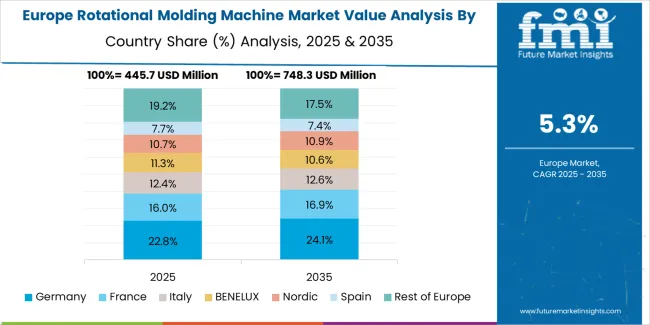
The rotational molding machine market in Europe is projected to grow from USD 563 million in 2025 to USD 947 million by 2035, registering a CAGR of 5.3% over the forecast period. Germany is expected to maintain its leadership position with a 38.2% market share in 2025, slightly declining to 37.8% by 2035, supported by its automotive manufacturing base and advanced processing technologies in regions including Bavaria and Baden-Württemberg.
Italy follows with a 24.6% share in 2025, projected to reach 25.1% by 2035, driven by comprehensive automotive supplier networks and material handling equipment production initiatives. The United Kingdom holds a 16.4% share in 2025, expected to maintain 16.7% by 2035 through established industrial manufacturing sectors and specialty component adoption. France commands an 11.8% share, while Spain accounts for 7.2% in 2025. The Rest of Europe region is anticipated to gain momentum, expanding its collective share from 1.8% to 2.4% by 2035, attributed to increasing industrial adoption in Nordic countries and emerging Eastern European manufacturing facilities implementing modern processing programs.
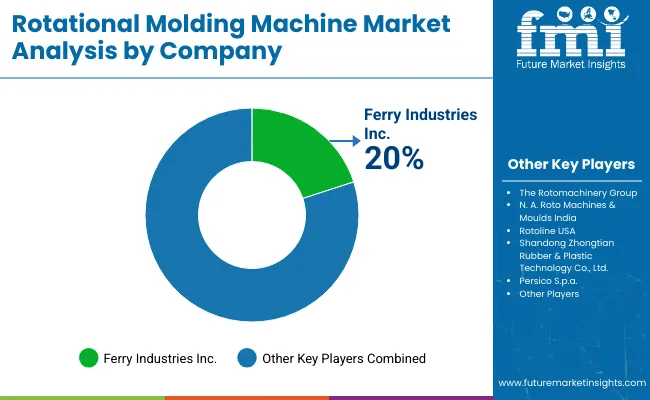
The rotational molding machine market operates with moderate concentration, featuring approximately 22-28 participants, where leading companies control roughly 38-44% of the global market share through established manufacturing expertise and comprehensive equipment portfolios. Competition emphasizes technological innovation, process efficiency, and automation capabilities rather than price-based rivalry.
Market leaders encompass Persico Group, Rotoline Machinery, and Ferry Industries Inc., which maintain competitive advantages through extensive engineering expertise, global service networks, and comprehensive machine design capabilities that create customer loyalty and support premium positioning. These companies leverage decades of rotomolding experience and ongoing technology investments to develop advanced systems with exceptional control features and production efficiency.
Specialty challengers include Orex Rotomoulding, Fixopan Rotomoulding Machines, and Reinhardt Roto-Machines, which compete through specialized equipment focus and innovative automation solutions that appeal to manufacturers seeking enhanced productivity capabilities and energy-efficient operation. These companies differentiate through application-specific machine design and advanced heating technology integration.
Market dynamics favor participants that combine reliable mechanical performance with comprehensive automation support, including process optimization and technical consultation capabilities. Competitive pressure intensifies as traditional machinery manufacturers expand into rotational molding systems. At the same time, specialized processing equipment companies challenge established players through innovative control solutions and cost-effective automation targeting growing industrial segments.
| Item | Value |
|---|---|
| Quantitative Units | USD 1,874 million |
| Product Type | Rock and Roll Machines, Shuttle Machines, Carousel Machines, Swing Arm Machines |
| Application | Automotive, Material Handling, Water Storage, Agriculture, Toys & Recreation, Others |
| Regions Covered | North America, Europe, Asia Pacific, Latin America, Middle East & Africa |
| Countries Covered | USA, Germany, Italy, China, India, and 25+ additional countries |
| Key Companies Profiled | Persico Group, Rotoline Machinery, Ferry Industries Inc., Orex Rotomoulding, Fixopan Rotomoulding Machines, Reinhardt Roto-Machines |
| Additional Attributes | Dollar sales by product type and application categories, regional adoption trends across North America, Europe, and Asia-Pacific, competitive landscape with machine manufacturers and equipment suppliers, manufacturer preferences for automation and efficiency optimization, integration with Industry 4.0 platforms and manufacturing systems, innovations in heating technology and process control, and development of energy-efficient solutions with enhanced production capabilities |
The global rotational molding machine market is estimated to be valued at USD 1,874.0 million in 2025.
The market size for the rotational molding machine market is projected to reach USD 3,419.9 million by 2035.
The rotational molding machine market is expected to grow at a 6.2% CAGR between 2025 and 2035.
The key product types in rotational molding machine market are rock and roll machines, shuttle machines, carousel machines and swing arm machines.
In terms of application, automotive segment to command 31.0% share in the rotational molding machine market in 2025.






Full Research Suite comprises of:
Market outlook & trends analysis
Interviews & case studies
Strategic recommendations
Vendor profiles & capabilities analysis
5-year forecasts
8 regions and 60+ country-level data splits
Market segment data splits
12 months of continuous data updates
DELIVERED AS:
PDF EXCEL ONLINE
Competitive Overview of Rotational Molding Machine Market Share
Molding Starch Market Size and Share Forecast Outlook 2025 to 2035
Bulk Molding Compounds Market Size and Share Forecast Outlook 2025 to 2035
Pulp Molding Tooling Market Size and Share Forecast Outlook 2025 to 2035
Blow Molding Resin Market Growth – Trends & Forecast 2024-2034
Pulp Molding Machines Market Size and Share Forecast Outlook 2025 to 2035
Rubber Molding Market Growth – Trends & Forecast 2024-2034
Lipstick Molding Machines Market Size and Share Forecast Outlook 2025 to 2035
Injection Molding Polyamide 6 Market Growth – Trends & Forecast 2024-2034
Injection Molding Containers Market
Injection Molding Machine Market Size and Share Forecast Outlook 2025 to 2035
Injection Molding Machines Industry Analysis in India Size, Share & Forecast 2025 to 2035
Auto Glass Moldings Market Analysis - Size, Share, and Forecast Outlook 2025 to 2035
Stretch Blow Molding Machines Market Segmentation based on Technology Type, Orientation Type, End Use, and Region: A Forecast for 2025 and 2035
Market Share Insights of Leading Stretch Blow Molding Machines Providers
Particle Foam Molding Machines Market Size and Share Forecast Outlook 2025 to 2035
Injection Blow Molding Machine Market from 2024 to 2034
Metal Injection Molding (MIM) Parts Market Size and Share Forecast Outlook 2025 to 2035
Powder Injection Molding Market Growth – Trends & Forecast 2025 to 2035
PET Stretch Blow Molding Machines Market Size and Share Forecast Outlook 2025 to 2035

Thank you!
You will receive an email from our Business Development Manager. Please be sure to check your SPAM/JUNK folder too.
Chat With
MaRIA